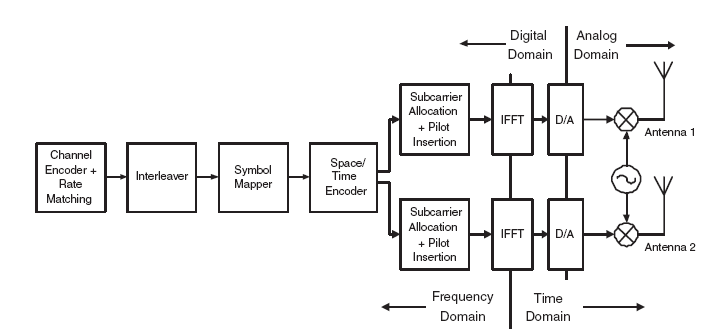

Figure 1 Functional Stages of WiMAX PHY
Figure 1 shows the various functional stages of a WiMAX PHY layer. The first set of functional stages is related to forward error correction (FEC), and includes channel encoding, rate matching (puncturing or repeating), interleaving, and symbol mapping. The next set of functional stages is related to the construction of the OFDM symbol in the frequency domain. During this stage, data is mapped onto the appropriate subchannels and subcarriers. Pilot symbols are inserted into the pilot subcarriers, which allows the receiver to estimate and track the channel state information (CSI). This stage is also responsible for any space/time encoding for transmit diversity or MIMO, if implemented. The final set of functions is related to the conversion of the OFDM symbol from the frequency domain to the time domain and eventually to an analog signal that can be transmitted over the air. Although Figure 1 shows only the logical components of a transmitter, similar components also exist at the receiver, in reverse order, to reconstruct the transmitted information sequence. Like all other standards, only the components of the transmitter are specified; the components of the receiver are left up to the equipment manufacturer to implement.
WiMAX supports a variety of modulation and coding schemes and allows for the scheme to change on a burst-by-burst basis per link, depending on channel conditions. Using the channelquality feedback indicator, the mobile can provide the base station with feedback on the downlink channel quality. For the uplink, the base station can estimate the channel quality, based on the received signal quality. The base station scheduler can take into account the channel quality of each user’s uplink and downlink and assign a modulation and coding scheme that maximizes the throughput for the available signal-to-noise ratio. Adaptive modulation and coding significantly increases the overall system capacity, as it allows real-time trade-off between throughput and robustness on each link.
Table 4 lists the various modulation and coding schemes supported by WiMAX. In the downlink, QPSK, 16 QAM, and 64 QAM are mandatory for both fixed and mobile WiMAX; 64 QAM is optional in the uplink. FEC coding using convolutional codes is mandatory. Convolutional codes are combined with an outer Reed-Solomon code in the downlink for OFDM-PHY. The standard optionally supports turbo codes and low-density parity check (LDPC) codes at a variety of code rates as well. A total of 52 combinations of modulation and coding schemes are defined in WiMAX as burst profiles.
Table 4 Modulation and Coding Supported in WiMAX
|
|
Downlink |
Uplink |
|---|---|---|
|
Modulation |
BPSK, QPSK, 16 QAM, 64 QAM; BPSK optional for OFDMA-PHY |
BPSK, QPSK, 16 QAM; 64 QAM optional |
|
Coding |
Optional: convolutional turbo codes at rate 1/2, 2/3, 3/4, 5/6; repetition codes at rate 1/2, 1/3, 1/6, LDPC, RS-Codes for OFDM-PHY |
Optional: convolutional turbo codes at rate 1/2, 2/3, 3/4, 5/6; repetition codes at rate 1/2, 1/3, 1/6, LDPC |
Because the physical layer of WiMAX is quite flexible, data rate performance varies based on the operating parameters. Parameters that have a significant impact on the physical-layer data rate are channel bandwidth and the modulation and coding scheme used. Other parameters, such as number of subchannels, OFDM guard time, and oversampling rate, also have an impact.
Table 5 lists the PHY-layer data rate at various channel bandwidths, as well as modulation and coding schemes. The rates shown are the aggregate physical-layer data rate that is shared among all users in the sector for the TDD case, assuming a 3:1 downlink-to-uplink bandwidth ratio. The calculations here assume a frame size of 5 ms, a 12.5 percent OFDM guard interval overhead, and a PUSC subcarrier permutation scheme. It is also assumed that all usable OFDM data symbols are available for user traffic except one symbol used for downlink frame overhead. The numbers shown here do not assume spatial multiplexing using multiple antennas at the transmitter or the receiver, the use of which can further increase the peak rates in rich multipath channels.
Table 5 PHY-Layer Data Rate at Various Channel Bandwidths
|
Channel bandwidth |
3.5MHz |
1.35MHz |
5MHz |
10MHz |
8.75MHz |
|||||
|
PHY mode |
256 OFDM |
128 OFDMA |
512 OFDMA |
1024 OFDMA |
1024 OFDMA |
|||||
|
Oversampling |
8/7 |
28/25 |
28/25 |
28/25 |
28/25 |
|||||
|
Modulation and Code Rate
|
PHY-Layer Data Rate (kbps) |
|||||||||
|
DL |
UL |
DL |
UL |
DL |
UL |
DL |
UL |
DL |
UL |
|
|
BPSK, 1/2 |
946 |
326 |
Not applicable |
|||||||
|
QPSK, 1/2 |
1882 |
653 |
504 |
154 |
2520 |
653 |
5040 |
1344 |
4464 |
1120 |
|
QPSK, 3/4 |
2822 |
979 |
756 |
230 |
3780 |
979 |
7560 |
2016 |
6696 |
1680 |
|
16 QAM, 1/2 |
3763 |
1306 |
1008 |
307 |
5040 |
1306 |
10080 |
2688 |
8928 |
2240 |
|
16 QAM, 3/4 |
5645 |
1958 |
1512 |
461 |
7560 |
1958 |
15120 |
4032 |
13392 |
3360 |
|
16 QAM, 1/2 |
5645 |
1958 |
1512 |
461 |
7560 |
1958 |
15120 |
4032 |
13392 |
3360 |
|
16 QAM, 2/3 |
7526 |
2611 |
2016 |
614 |
10080 |
2611 |
20160 |
5376 |
17856 |
4480 |
|
16 QAM, 3/4 |
8467 |
2938 |
2268 |
691 |
11340 |
2938 |
22680 |
6048 |
20088 |
5040 |
|
16 QAM, 5/6 |
9408 |
3264 |
2520 |
768 |
12600 |
3264 |
25200 |
6720 |
22320 |
5600 |